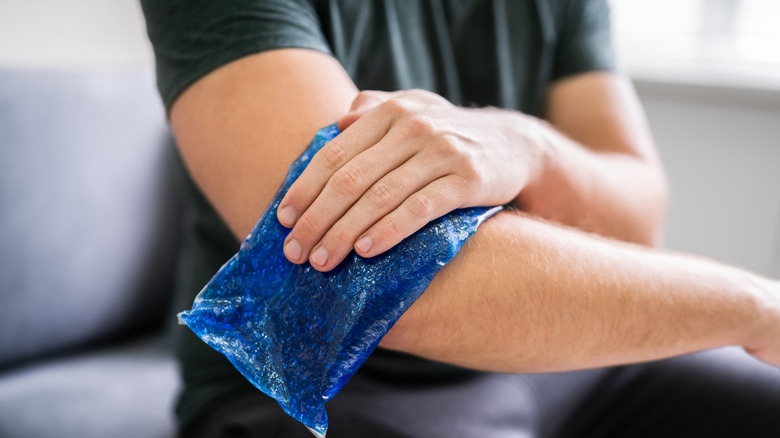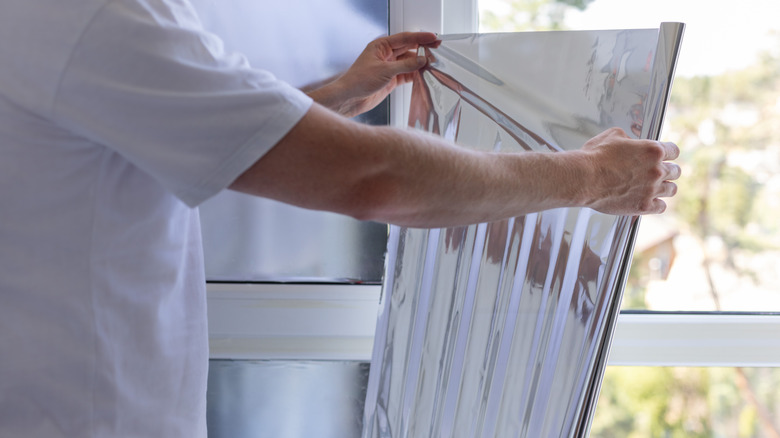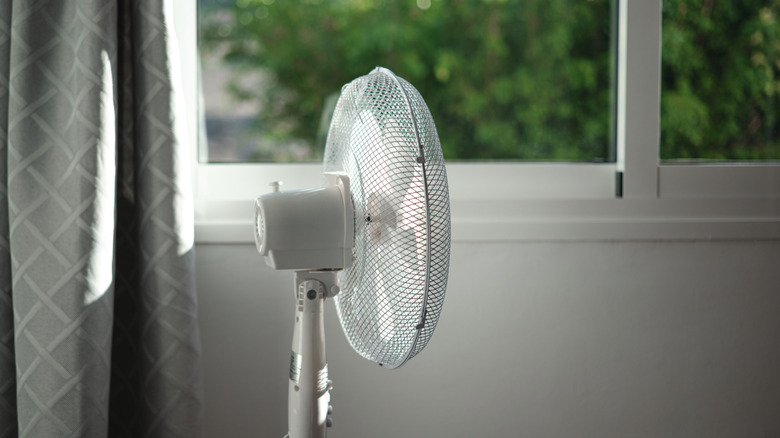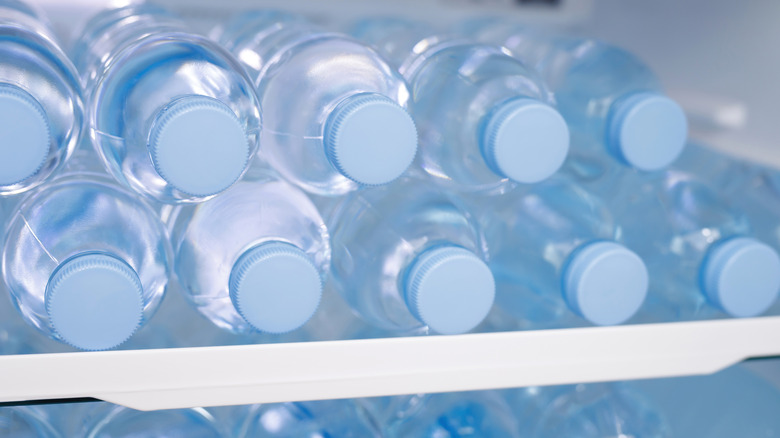9 Ways To Repurpose Items Around The House To Stay Cool In Sweltering Heat
It's easy to glamorize summer with its sunny days and cool nights. However, when the heat waves come around, summer isn't so ideal. Air conditioning (AC) units struggle to keep homes cool, especially older units, so you may have to take extra measures to keep a house cool and comfortable. Fortunately, there are many ways to regulate your home's interior temperature using common household items.
Below are nine ways to cool down your home without investing in a new AC unit. Even if your AC unit is up and running, these methods can help carry the workload, keeping your home cooler without using so much energy. This reduces your electricity use and cools your home using solely common household items, making these tips budget-friendly and easy for anyone to incorporate. Read on to learn how to use these ideas to stave off a heat wave, as well as the science behind why it works.
Keep a reusable ice pack on hand to cool your body
Reusable ice packs are good for soothing injuries and preserving food, but consider using them to keep your body temperature down. Simply grab a pack from the freezer and press it against your skin throughout a hot day. Don't exceed 20 minutes in one spot since holding an ice pack in one place for too long causes burns. Take a 20-minute break before putting it back on the same spot, or use it to cool another body part while you wait. Reduce the risk of a burn by putting a thin towel or article of clothing between the skin and ice pack.
Be pragmatic about where you place the ice pack to get the best results. Hold it at the base of your neck, wrists, forehead, under your arms, and between your thighs. These body parts are full of blood vessels that generate a lot of heat, so the ice pack cools the blood as it recirculates through your body, helping to cool your entire system. A person's wrist and forehead are also good spots, but may be impractical to hold an ice pack against while doing other things.
Put aluminum foil-covered cardboard over your exterior windows to reflect sunlight
If you don't mind being judged by your neighbors, tack aluminum foil over your windows to keep your home cool. Avoid the biggest mistakes you can make when lining windows with repurposed foil by using heavy-duty foil and a layer of cardboard. Make sure you place the makeshift insulation panel over the exterior side of a window. This is an alternative DIY method to insulating panels that, instead, uses household items. Simply make sure the foil side is facing the sun, and use one extra large piece of foil rather than many small pieces. The gaps in smaller pieces let heat through, compromising its effectiveness.
Aluminum foil only absorbs about 5% of infrared light but it reflects about 95%. This directly combats the heat from the sun's rays by reflecting them away from the window glass. Cardboard is nowhere near as insulative as aluminum foil, but it still absorbs some heat, which helps block the non-reflected rays from passing through the window.
Point fans at drafty doors and windows to combat warm air
If your landlord or current financial situation inhibits you from using some of the best options to insulate drafty windows, it's time to put a floor or tabletop fan to work. Set up the fan facing across from the window, making sure it's pointed at the general location of the draft. The force of its spinning blades should send the hot air from outside back from where it came. If you have more than one spare fan, set them up around the room, directing cool air into warmer areas to further improve airflow.
Arranging your fans in this position is a great alternative to cool down a hot room, as they interrupt the flow of warm drafts as they seep into your home. The cold interior air meets the heat, creating a cross-breeze. The cross-breeze keeps fresh air moving through the room, making it feel cooler. This method is best used in the hottest and sunniest location of a home.
Direct fans at bowls of ice to keep cool
Portable AC units aren't cheap, and sometimes traditional fans aren't powerful enough to cool a room on their own. Upgrade a floor or table fan using items likely already in your freezer. Fill a large mixing bowl or shallow pan with ice and set it down in front of a fan. Angle the mixing bowl so that it gets hit with more air, but without the ice or melted ice dripping out, to make it even more effective.
When the fan air meets the ice, it becomes colder. Therefore, the direct path of air coming from the fan maintains a chillier temperature. Bear in mind that the air won't maintain its coldness or spread around the room, so the fan should be pointed directly at the area you intend to keep cool. Ice works well for this because ice is highly absorbent of heat, and it takes a lot to increase its temperature. However, once it starts melting, it absorbs heat quicker, meaning you'll need to replace the bowl or pan as the ice liquefies.
Put bed sheets in the freezer to help you fall asleep
There's nothing more miserable than being hot and uncomfortable before bed. About an hour before bedtime, try putting your bed sheets in a plastic bag in the freezer. This should give them enough time to get down to temperature before you remove them and curl up for sleep. However, don't add any water to the sheets before freezing, as some people may recommend. The sheets will stay colder for longer, but when the ice melts and the cold fades, your bed will be both warm and damp.
The sheets work as a giant, lightweight ice pack, directly cooling your skin and blood vessels for a short time. Make sure to use thin sheets made of breathable fabrics that allow adequate airflow. Cotton, linen, and rayon fabrics meet this criteria, and sheets made of this material should help you stay cool as they absorb body heat. Use this method and other tips to keep your mattress cool during toasty summer nights.
Freeze a water bottle to make a DIY cooling ice pack
When no ice packs are available, a frozen water bottle comes in handy. Put tightly sealed plastic water bottles in your freezer and let them sit for about three hours. Be careful not to fill them all the way, as you'll want to leave some space for the water to expand as it freezes. Once frozen, take them out one by one and use them as cooling packs to directly lower body temperature.
This water bottle trick should be followed the same way as the ice pack method — only leave the icy bottle on your skin for up to 20 minutes at a time, with long breaks in between. It'll cool your blood vessels but cause ice burns if you aren't careful. You can also use this trick to keep your bed cool, making it a genius repurposing hack for power outages. Just be careful not to let the bottle touch your skin directly by laying it on top of the sheet. Also, ensure the bottle is fully sealed, so it doesn't leak and dampen your mattress.
Hang a wet sheet in front of an open door or window to create a cool breeze
When AC units fail, use the resources Mother Nature provides and intentionally open a door or window to let outdoor air in. But first, hang a dampened sheet in front of the door or window, and be careful not to let it drip on anything that's vulnerable to moisture. It should turn the air from outdoors into a cool breeze that wafts over your interior, providing all-natural cooling.
This idea for cooling down a room works because the outdoor air causes moisture in the sheet to evaporate, which creates a cooling effect. This also works in front of windows and vents (when the AC is working). If you want to kill two birds with one stone, hang wet laundry in front of the window to dry and cool. This provides cooling and dries your laundry. The only caveat to this tip is that you must be wary of humidity. Too much moisture in your home could be an issue, so ensure the room has proper ventilation. So, this tip should never be incorporated in compact, enclosed rooms like small bedrooms.
DIY a homemade air conditioner using a foam cooler, fan, and PVC pipes
Take a crafty approach and DIY a homemade air conditioner to run alongside or in place of a home unit. Search your home for a foam cooler, spare PVC piping, and a tabletop fan. If you don't have PVC pipes on hand, use other cylindrical objects, like toilet or paper towel rolls, though they may not be as effective. A helpful TikTok video provides directions for assembly, using the foam cooler as the cooling source, the fan as the blower, and the pipes to direct the air. Fill the cooler with ice or frozen water bottles, turn on the fan, and let it work its magic.
This innovative creation is a rudimentary version of a modern AC unit. The fan pushes air through the cooler and out the pipes. As the air hits the cooler ice, its temperature lowers before it's emitted through the pipes and into the surrounding room. A standard polystyrene foam cooler is the best choice for this job since its material keeps the ice preserved for longer — it's also much easier to cut than other materials. You could use cardboard or a hard plastic cooler, but the cardboard wouldn't insulate for as long, and the hard plastic cooler will be very difficult to cut.
Hang sheets over windows without blinds or curtains to keep sunlight and heat out
Filling your home with natural light is a proven method to improve your mindset and mood. However, when blistering heat is added to the mix, it isn't so satisfying. "'Consider keeping your blinds and curtains closed during the hottest hours of the day," Jeramy Sibley, the Glass Doctor company's president, advised Homes & Gardens. "It may be a bit darker, but it will be worth it for the lowered temperature." Make sure all blinds and curtains are closed throughout your home. If any windows or glass doors don't have a heat-blocking curtain for the summer, tack sheets above them. Use thumbtacks, command strips, or adhesive hooks to cause minimal damage using this temporary solution.
If you need more motivation to shroud your home in darkness, know that window coverings can lower interior temperatures up to 20 degrees. The U.S. Department of Energy even reported that "medium-colored draperies with white plastic-backings" reduce up to 33% of heat. Following this logic, look for a medium to dark-colored sheet, such as a thick duvet cover or blanket, or one made of heavier material to help cool your interior atmosphere.






